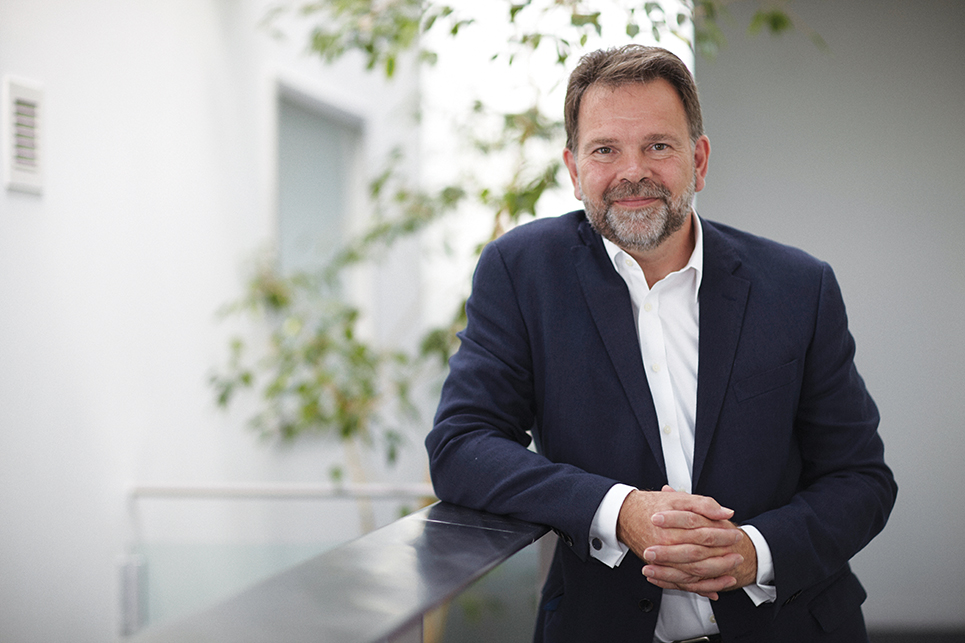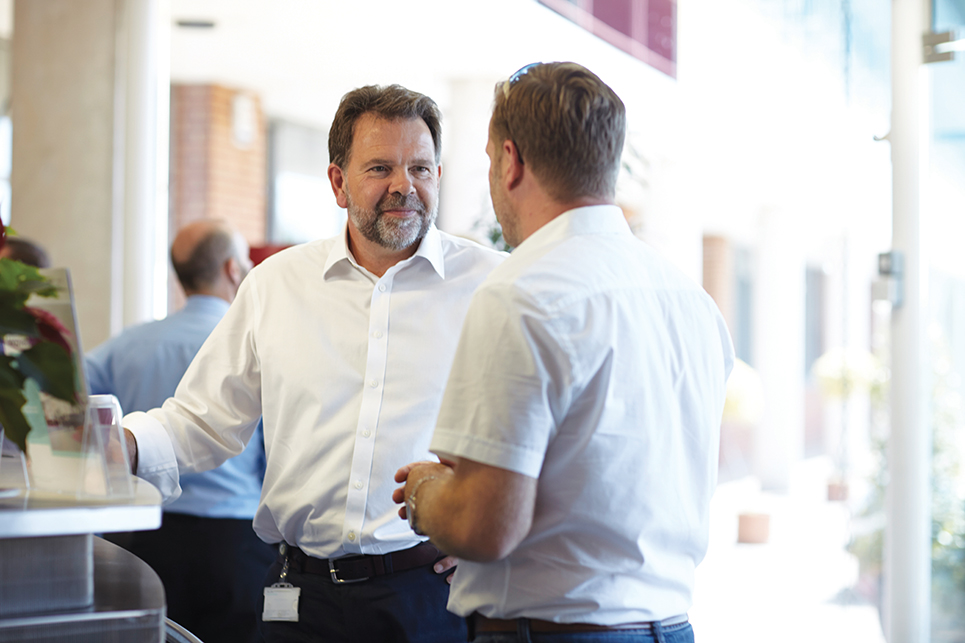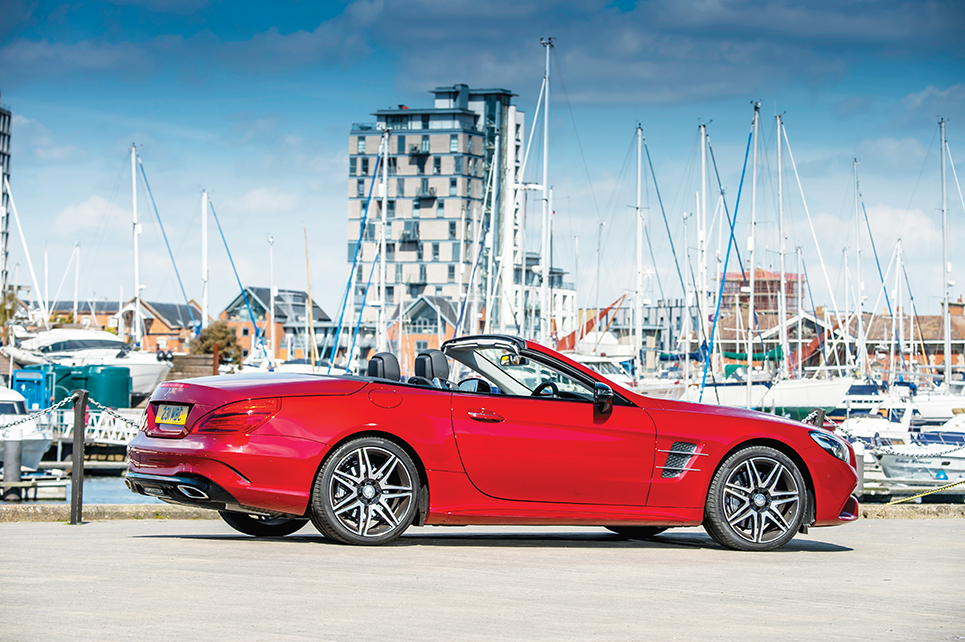
Contrary to popular perception there was a time, albeit very briefly, when the Sussex Innovation Centre (SINC) existed without its Executive Director, Mike Herd, though it’s hard to imagine SINC without Mike.
“No, I can’t claim to have started the centre,” replies Mike when I ask. “I came in as the first director. When I joined in February 1997, the centre had been open for about eight months.”
Opened in 1996, The Sussex Innovation Centre, is a commercial business centre, nestling on the leafy University of Sussex campus at Falmer. It is a stimulating location for entrepreneurs, start-ups and innovative growing companies, offering strategic advice, a willing business support team and, for those who need it, flexible, professional office space.
It is solely owned by the university, but it wasn’t always the case, as Mike recalls: “The original concept evolved in the mid-90s from grouping called the Sussex Academic Corridor, which included the FE college, both universities, and the Brighton and East Sussex councils. The idea was to make better economic use of the land and solve the issue of finding a place for start-ups to go. Brighton was a failing economy at that time, so the question was whether universities be used for greater economic impact? SINC was one of five projects set up by the Sussex Academic Corridor, but we were the only one who carried on.”
“A significant proportion of the funding for the SINC development originated from the ‘planning gain’ from ASDA development at Hollingbury, though they were probably never aware of the contribution they made. SeeBoard (now EDF Energy) was a key sponsor and supporter from the beginning. The land was provided by the University of Sussex. But the crucial element was creating a project which would be self-sustaining, to avoid creating a centre which would quickly run out of funds.
“The key thing was that it was set up to be a business, not a project”, says Mike. “So often projects run out of money and everything stops. There was a fairly open remit in what to do with the building and it was allowed to evolve like a business as opposed to ‘Here’s your business plan, deliver that and then we’ll see what happens’.
“When I came in, it was probably an advantage that I knew absolutely nothing about small businesses. I’d come from the oil industry working as a rock physicist. I had spent the previous three or four years working in Eastern Siberia, South America and the Middle East. Not having had a lot of experience in setting up new companies enabled me to to ask direct questions to entrepreneurs such as: ‘What’s stopping you? What do you need to grow this business and how can I help?’
“I’d made money out of science and I had some knowledge of technical businesses. I created a shop window of technology businesses and then the word started to spread.
“I was given a huge amount of freedom by the shareholders. As long as I wasn’t committing fraud or laundering money they were quite happy with what we were doing. We could generate results in terms of successful businesses being created and do it in a financially self-sustainable way.”
The centre soon attracted dynamic young businesses and gained momentum. But this presented its own problems, as Mike explains: “When we looked to grow the business and expand, it started to get more complicated. Would the University of Brighton want to invest in something situated on the University of Sussex site? Also we were attracting interest from local investors who wanted to buy us but politically it was very difficult to bring private money into what was essentially a public sector organisation.
“Fortunately, the University of Sussex understood the strategic value and how much the university needed to be aligned with business growth. So they took the decision to buy out the other academic partners to simplify our structure and enable us to support the university.”
The University of Sussex bought out the academic partners in 2003 and took over 100% ownership in 2008, which had an impact on the centre. Mike recounts the change: “We were asked to apply our model inside the university, not just to companies outside. How could we help commercialise research, and encourage student enterprise and entrepreneurship?”
Mike neatly surmises the original model into a three-point plan.
“Firstly, you create a building providing a place for people to work, which they can afford.
“Secondly you then provide a community by having like-minded people. That sounds very simple but very few places actually do that.
“Thirdly was trying to work out what businesses needed to grow and then going out to find the expertise or the money in order to help them do it.
“We’ve built up our experience and have been able to spot where the gaps are. As an example, in the early 2000s, we had a company going through a floatation and another sourcing a big investment, and both had quite amateurish accounts records. They had local accountants but it was such a far way from what investors were looking for. What an accountant provides for a start-up wasn’t suitable for a company that was going for high growth.
“I thought that these companies have to pay for bookkeeping, payroll and basic account management. What if we provide that and then added value by teaching them how to use that financial information to understand how to grow the business, and how to do proper forecasting. That’s become a huge success.
“In a similar way there was often a lack of management experience and business knowledge, which meant we found it very difficult to attract investors into some of the companies at the time of the dotcom boom. I decided to create corporate networks and recruit customer mentors, enabling the entrepreneurs to become investible. These were things nobody else was doing.”
SINC has established an enviable record of pushing small companies through rapid growth phases. Is the emphasis now on established companies that are looking to grow rather than new start-ups?
“We’re very good at helping people start a new business. We’ve got that pretty well sussed. Where I think we can provide far greater value is helping people to grow a business. That the time when most incubators push people out but actually it is a far more complex area when you are looking to build a management team, a scalable business model, and move from a couple of hundred thousand pounds a year to a couple of hundred thousand pounds a month. There’s a massive change in how a business operates and that’s where we try to put a lot of our support resources and help make that transition.
“A lot of the success we have had has been in supporting highly complex technology businesses is to find simple solutions.
“We want companies to get better valuations for investment so we help them understand and present their financial growth model. We want the companies to grow and employ graduates – so we hire the graduates, train and resource them and rent them out by the hour until the companies can afford to employ themselves.
SINC does accept early-stage start-ups and small businesses looking to grow, but all must have one vital ingredient - ambition.
“We expect people to want to grow and we deliberately put them in rooms that are slightly too big for them” says Mike. “The first challenge is to prove that the business model and product can work and that there is demand for it, and then how do you take that business and start growing it? About 20-25% of those companies move into a high growth phase, and that’s a high percentage. Taking companies that don’t want to grow just clogs up the space. The ones that are high growth will naturally move on from here which is what we want to see happen. We churn about 30% of the space each year.”
And what if a business isn’t showing the inclination to grow? Mike’s reply may be slightly tongue-in-cheek (or maybe it isn’t!): “We keep putting the rents up for people who aren’t doing anything. We limit how much space they can have because we don’t want them to just stay in that space, and we just keep putting pictures of other buildings under their door every morning until they get the hint!”
SINC has been expanding its reach over the last few years with a new centre close to East Croydon Station and plans for a base close to Brighton Station.
The Croydon initiative begs the obvious question - why would a Sussex initiative want a South London Centre?
“There were several reasons for Croydon. One was that we really see the potential of that whole A23/M23 corridor and the way in which we can engage with businesses and help them. An awful lot of businesses have potential clients and business in London, so it provides a stepping stone for companies from Brighton to get into London.
From the university perspective it is a very different type of economy that you’re working with in Croydon. Brighton is a fantastic place but there aren’t that many large companies that the university can engage with.
“There’s a very big difference between being in a city centre and being on a campus. In Croydon a lot of people will be walking in, using the property in a different way, such as our business lounge.
“Of course, some people look at us with complete incredulity saying: ‘But you’re called Sussex. You’re in Croydon’. The biggest mistake was putting a picture of the University of Sussex campus on the wall, where you could see the Amex stadium in the corner. From the upper levels of the Croydon building you can see the Crystal Palace Stadium, so our picture didn’t go down terribly well. But seriously it is about us being in London and trying to make the model work there, and not seeing it as North Sussex
“The sectors where the Croydon community have done very well are in software development (notably in virtual and augmented reality), social enterprise and ethical finance.
“At the Sussex centre, by comparison, some of our biggest investments into high growth companies have been in biotech and drug discovery. These sectors benefit from the university environment, with the physical facilities and access to labs.
“We are now developing an innovation centre on the biotech side which will be housed in the new life science building on campus, so we will be looking for lab-based companies. People don’t think of Brighton in this area but recently Enterprise Therapeutics have won £19 million funding for their drug discovery area. We had Destiny Pharma who floated in September which was the biggest UK biotech float in 2017.”
It may well be the new bio-tech Innovation Centre will open before the mooted new SINC in the centre of Brighton. Opening the new centre has been a frustrating experience as Mile explains: “There was an issue in terms of the main building contractor going bust. The site is next to steps and the lift going down from the back of the station. The station side is six floors of a new office block which we hope will be the new innovation centre in Brighton and then on the other side is a new hotel. We’re in the final re-negotiations after the delays as to whether we can make that innovation centre there, which is firmly our hope. If not we’ll look elsewhere to create that centre.
“There is very much a need for us to be more actively engaged with the Brighton community businesses by being in Brighton. There is a lack of space for growing businesses who can no longer fit in the incubation hubs. If a company is on a high growth path then they may be doubling in size each year. Where do they take a five-year lease, for how much space and how do you manage that? We want to help solve that problem and give more access to our support team. Effectively it is taking the model which has worked in Croydon and applying it back to Brighton.”
After 21 years at SINC, the obvious question is what is Mike most proud of? “I’m proud that we have had two floatations, both on the biotech side. One was Genpak back in 2000. Genpak made equipment and reagents for DNA analysis and was bought by biotechnology PLC Genetix Group for £6.5 million prior to the floatation. Secondly Destiny Pharma who floated last year.
“The key thing for me is how people change personally and realise their ambition themselves. Sometimes we work with an academic who will then come back and say ‘Actually, I’ve found this whole business side as stimulating and invigorating as my research,’ which is a really satisfying thing. To see technology getting out there and actually solving a problem, that’s huge.
“To be honest, it’s less about the money. The money will flow if they’re successful; it’s about seeing an idea come to fruition and the growth an innovator has to go through in order to do that.
“It’s also been interesting in how the centre and the university has changed over the years. People will often look at a university and say, ‘I tried to work with them 10 years ago and it didn’t work’. Universities have changed in the way that they work and interact with businesses. People need to be very open-minded about how they work with the higher education sector to get the most out of it and for everyone to gain.
“Also start-ups still need supporting and we still need to develop the ambition, new entrepreneurs and new products and new ideas.”
And what about Mike? After two decades is he still as motivated and excited by the role?
“Absolutely. Every day I’m dealing with new ideas. What could be more stimulating and invigorating than that? There’s still more to do. We’ve been allowed to build the innovation centre as a business which is resilient and sustainable, has built its own staff and reputation, and pipelined a business.
‘My job has continued to change every year and that’s what makes it fascinating. The university has changed and Brighton as an economy has changed. We’re doing a lot more work with corporates who want to engage with start-ups and early stage businesses to see how these product innovations can be applied and grow more broadly. This is a very exciting area, where we will see substantial growth.”








